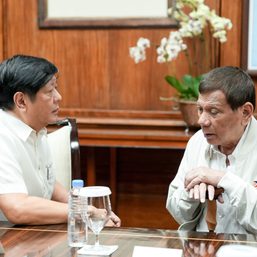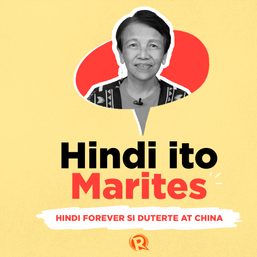SUMMARY
This is AI generated summarization, which may have errors. For context, always refer to the full article.

President Rodrigo Duterte has created 15 task forces since the start of his administration and plans to create another one to tackle rehabilitation of areas devastated by Typhoon Ulysses (Vamco).
Observers have recently quipped about Duterte’s penchant for creating task forces because barely a month ago, he announced the creation of a “mega task force” on government corruption.
In 2020 alone, Duterte has put together 5 task forces.
Some have become familiar to most regular Filipinos, like the Inter-agency Task Force on Emerging Infectious Diseases (IATF-EID) taking the lead on the coronavirus health crisis.
One task force, the National Task Force to End Local Communist Armed Conflict (NTF-ELCAC), has become notorious for its persistent red-tagging.
List of Duterte task forces
Here’s the list of Duterte-time task forces, based on official documents uploaded on the Official Gazette and Duterte’s verbal declarations:
- “Mega task force” on government corruption (October 2020)
- Task force to investigate PhilHealth anomalies (August 2020)
- National Task Force Against COVID-19 (March 2020)
- Task Force vs African Swine Flu (February 2020)
- Inter-agency Task Force on Zero Hunger (January 2020)
- Reactivated and reconstituted El Niño Task Force (August 2019)
- Manila Bay Task Force (February 2019)
- National Task Force to End Local Communist Armed Conflict (December 2018)
- Inter-agency Task Force on Federalism and Constitutional Reform (October 2018)
- Boracay Inter-agency Task Force (May 2018)
- Inter-agency Task Force for the Reintegration of Former Rebels and Former Violent Extremists (April 2018)
- Inter-agency Task Force on Yolanda (August 2017)
- Marawi Rehabilitation Task Force (June 2017)
- National Anti-Illegal Drug Task Force (March 2017)
- Presidential Task Force on Violations of the Right to Life, Liberty and Security of the Members of the Media, later on shortened to Presidential Task Force on Media Security (October 2016)
Even past presidents
But Duterte is hardly the first president to use task forces. His predecessor, Benigno Aquino III, had also created separate task forces for the aftermaths of Super Typhoons Pablo and Yolanda.
At least two of Aquino’s task forces are active to this day, the IATF-EID (yes, that was Aquino’s 2014 creation) and the National Task Force on the West Philippine Sea.
Gloria Macapagal Arroyo also created task forces. Her Presidential Task Force on Climate Change, formed in February 2007 through an administrative order, was led by her environment secretary.
In 2005, Arroyo created the National Anti-Crime Task Force to “streamline” other government efforts against criminality.
In the same year, she created a special task force to protect Filipino entertainers in Japan from exploitation by traffickers.
Presidents have turned to task forces for a reason, said University of the Philippines poltical science department chairperson Herman Kraft.
“Task forces are good, especially for multifaceted issues. You need more than one office to act on it,” he told Rappler.
Task forces, based on how past Philippine presidents have used them, are typically comprised of various departments, like the Department of Health or the Department of Education, which should now be able to more efficiently coordinate with one another on a specific issue or goal – say, the pandemic and protocols for schools given the health crisis.
They usually implement a policy crafted by another entity – say, the Cabinet or a council.
“A council is a stand-alone policy-making body, like the National Security Council, for example, responsible for an entire area of concern like security, housing, finance,” said Kraft.
In the Duterte government’s pandemic efforts, the IATF-EID has been functioning like a council, creating policies (in the form of resolutions), that are then implemented by the National Task Force vs COVID-19, a Duterte creation that put retired military generals in charge of executing and coordinating government programs.
One point person
One other virtue of task forces, as repeatedly mentioned by Presidential Spokesman Harry Roque, is that it puts a single official in charge, making it easier for the President to see a single chain of command he can turn to.
“I guess the task force is really to stress that someone needs to be in charge and the person in charge is the Executive Secretary, with the full assistance of the Cabinet,” said Roque on Monday, November 17, after announcing that Executive Secretary Salvador Medialdea was tapped by Duterte to lead the upcoming task force on Ulysses rehabilitation.
Rene Almendras, Cabinet secretary during the Benigno Aquino III administration, said this was also the value of task forces back in their time.
“When there was an urgency and it involved more than one agency that needed to be coordinated well, a task force was formed. But more importantly, someone was designated to lead and focus on the matter,” he told Rappler.
Almendras himself led the Typhoon Pablo task force. When a task force was created for Yolanda, Panfilo Lacson was brought in to lead it, as rehabilitation czar.
The catch with task forces
There’s nothing inherently wrong with task forces. But their frequent creation is a bad sign for any government.
“It does not reflect well on government if task forces are constantly being set up to respond to a problem,” said Kraft.
This is because it’s a symptom that existing institutions, like executive agencies, commissions, maybe even entire systems like the judiciary, can’t adequately respond to these problems.
The need to constantly form task forces shows an inclination towards “ad hocism” and a lack of trust or interest in institutions, said Kraft.
What ends up happening is that existing agencies, like the departments, have to funnel their funds into the task forces they are part of. So the department programs that the budget was intended for get defunded.
In the case of Duterte’s planned typhoon task force, it’s a repeat of many other typhoon task forces that could indicate shortcomings of the National Disaster Risk Reduction and Management Council (NDRRMC), the highest coordinating body tasked to prepare for, and respond to, calamities.
The NDRRMC was created during the Arroyo administration and is led by the defense secretary. It’s comprised of the same agencies as those in the past and present typhoon task forces.
An end to task forces?
Roque said the NDRRMC is “not enough” to address the effects of Ulysses. Almendras echoed the sentiment, specifying that the council could be enough for regular storms, but not for extremely destructive ones.
“NDRRMC was only up to disaster relief and risk mitigation and the destruction was so massive, it required Cabinet members’ direct involvement and the challenge is to execute and execute in a timely manner,” said Almendras.
For this reason, Duterte has called for the creation of a Department of Disaster Resilience, strongly supported by Defense Secretary Delfin Lorenzana.
The department is supposed to be a version of the NDRRMC with more teeth and with more focus on rehabilitation, rather than just immediate relief efforts.
Vice President Leni Robredo has said the proposal is “worth studying” but that lawmakers and the executive have to make sure they aren’t just creating more unnecessary levels of bureaucracy that could slow down disaster response, rather than speed it up.
The frequent creation of task forces sends a signal that a lasting mechanism to constant threats like freak storms and viruses is needed, whether its strengthening the NDRRMC or creating totally new agencies. – Rappler.com
Add a comment
How does this make you feel?

![[The Slingshot] Alden Delvo’s birthday](https://www.rappler.com/tachyon/2024/04/tl-alden-delvo-birthday.jpg?resize=257%2C257&crop=263px%2C0px%2C720px%2C720px)
![[EDITORIAL] Ang low-intensity warfare ni Marcos kung saan attack dog na ang First Lady](https://www.rappler.com/tachyon/2024/04/animated-liza-marcos-sara-duterte-feud-carousel.jpg?resize=257%2C257&crop=294px%2C0px%2C720px%2C720px)
![[Newsstand] Duterte vs Marcos: A rift impossible to bridge, a wound impossible to heal](https://www.rappler.com/tachyon/2024/04/duterte-marcos-rift-apr-20-2024.jpg?resize=257%2C257&crop=278px%2C0px%2C720px%2C720px)

There are no comments yet. Add your comment to start the conversation.